The AMD A10-7700K and AMD A6-7400K CPU Mini-Review
by Ian Cutress on May 27, 2015 9:00 AM ESTOffice Performance
The dynamics of CPU Turbo modes, both Intel and AMD, can cause concern during environments with a variable threaded workload. There is also an added issue of the motherboard remaining consistent, depending on how the motherboard manufacturer wants to add in their own boosting technologies over the ones that Intel would prefer they used. In order to remain consistent, we implement an OS-level unique high performance mode on all the CPUs we test which should override any motherboard manufacturer performance mode.
All of our benchmark results can also be found in our benchmark engine, Bench.
Dolphin Benchmark: link
Many emulators are often bound by single thread CPU performance, and general reports tended to suggest that Haswell provided a significant boost to emulator performance. This benchmark runs a Wii program that raytraces a complex 3D scene inside the Dolphin Wii emulator. Performance on this benchmark is a good proxy of the speed of Dolphin CPU emulation, which is an intensive single core task using most aspects of a CPU. Results are given in minutes, where the Wii itself scores 17.53 minutes.
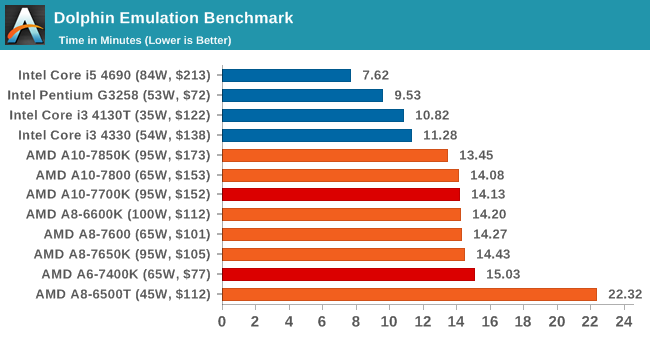
WinRAR 5.0.1: link
Our WinRAR test from 2013 is updated to the latest version of WinRAR at the start of 2014. We compress a set of 2867 files across 320 folders totaling 1.52 GB in size – 95% of these files are small typical website files, and the rest (90% of the size) are small 30 second 720p videos.
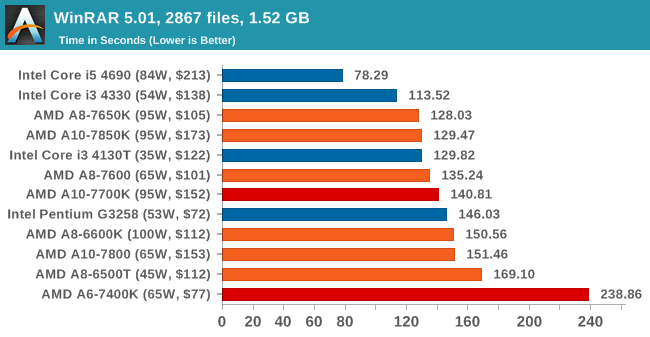
The single module of the 7400K shows the deficit in a slightly threaded workload.
Image Manipulation – FastStone Image Viewer 4.9: link
Similarly to WinRAR, the FastStone test us updated to the latest version. FastStone is the program I use to perform quick or bulk actions on images, such as resizing, adjusting for color and cropping. In our test we take a series of 170 images in various sizes and formats and convert them all into 640x480 .gif files, maintaining the aspect ratio. FastStone does not use multithreading for this test, and thus single threaded performance is often the winner.
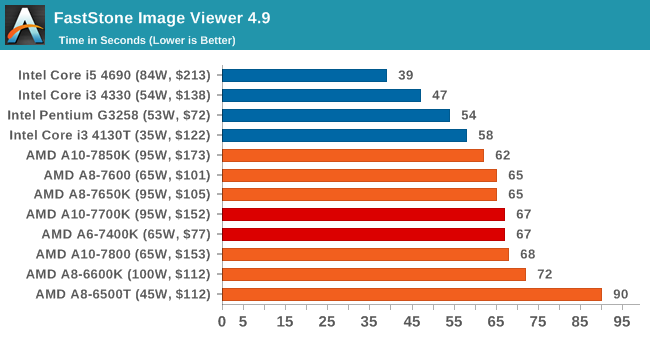
For a purely single threaded test, both of the AMD APUs performed similarly here.
Web Benchmarks
On the lower end processors, general usability is a big factor of experience, especially as we move into the HTML5 era of web browsing. For our web benchmarks, we take well known tests with Chrome 35 as a consistent browser.
Mozilla Kraken 1.1
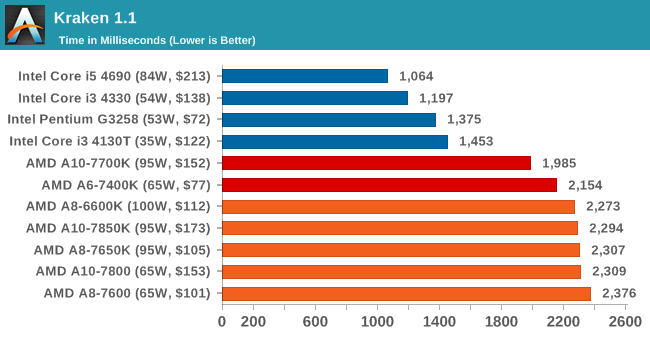
Google Octane v2

Professional Performance: Windows
We have a few benchmarks to characterise professional level performance on Windows.
Agisoft Photoscan – 2D to 3D Image Manipulation: link
Agisoft Photoscan creates 3D models from 2D images, a process which is very computationally expensive. The algorithm is split into four distinct phases, and different phases of the model reconstruction require either fast memory, fast IPC, more cores, or even OpenCL compute devices to hand. Agisoft supplied us with a special version of the software to script the process, where we take 50 images of a stately home and convert it into a medium quality model. This benchmark typically takes around 15-20 minutes on a high end PC on the CPU alone, with GPUs reducing the time.
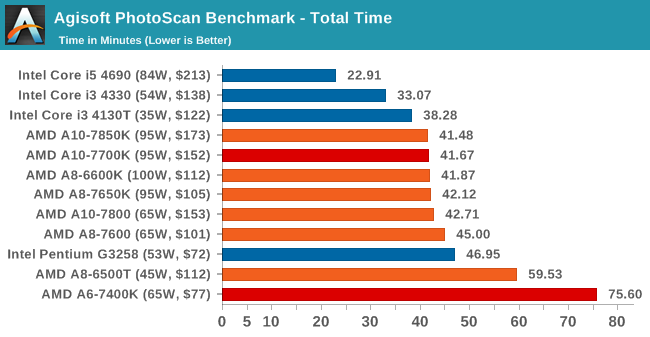
Cinebench R15
Cinebench is a benchmark based around Cinema 4D, and is fairly well known among enthusiasts for stressing the CPU for a provided workload. Results are given as a score, where higher is better.
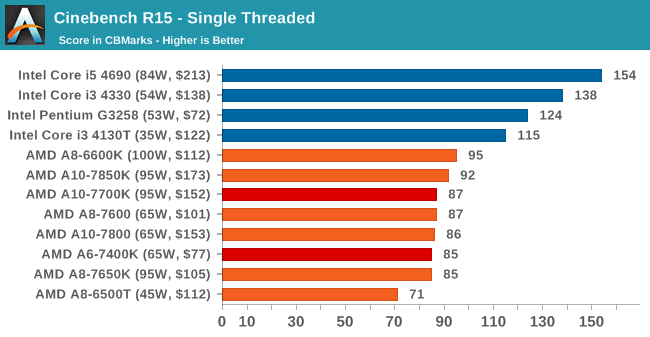

Linux Performance
Built around several freely available benchmarks for Linux, Linux-Bench is a project spearheaded by Patrick at ServeTheHome to streamline about a dozen of these tests in a single neat package run via a set of three commands using an Ubuntu 11.04 LiveCD. These tests include fluid dynamics used by NASA, ray-tracing, OpenSSL, molecular modeling, and a scalable data structure server for web deployments. We run Linux-Bench and have chosen to report a select few of the tests that rely on CPU and DRAM speed.
C-Ray: link
C-Ray is a simple ray-tracing program that focuses almost exclusively on processor performance rather than DRAM access. The test in Linux-Bench renders a heavy complex scene offering a large scalable scenario.
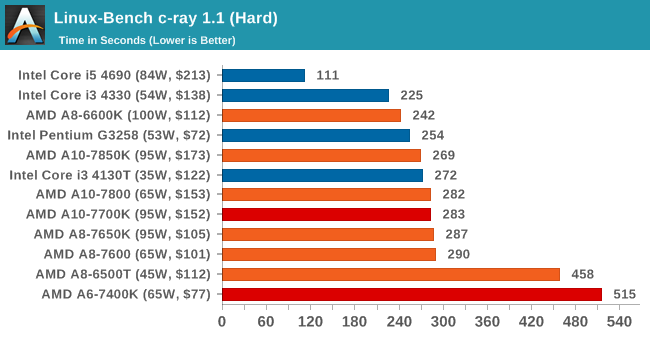
NAMD, Scalable Molecular Dynamics: link
Developed by the Theoretical and Computational Biophysics Group at the University of Illinois at Urbana-Champaign, NAMD is a set of parallel molecular dynamics codes for extreme parallelization up to and beyond 200,000 cores. The reference paper detailing NAMD has over 4000 citations, and our testing runs a small simulation where the calculation steps per unit time is the output vector.
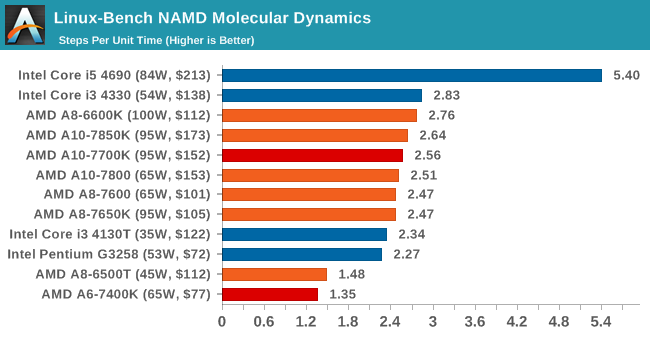
NPB, Fluid Dynamics: link
Aside from LINPACK, there are many other ways to benchmark supercomputers in terms of how effective they are for various types of mathematical processes. The NAS Parallel Benchmarks (NPB) are a set of small programs originally designed for NASA to test their supercomputers in terms of fluid dynamics simulations, useful for airflow reactions and design.











105 Comments
View All Comments
Edens_Remorse - Wednesday, May 27, 2015 - link
8370e($120) + ASRock 970M Pro 3 mATX($15... yes $15) and a Raijintek Pallas CPU cooler($33) is an absolute monster combination that will only get better with dx12. Show me a combination that comes close to that performance for anywhere near the price. I loved my 4790k, but appreciating what one has in no excuse for ignorance.azazel1024 - Wednesday, May 27, 2015 - link
Which may be a long time in coming. I look forward to it, but with GPUs being limited to 4GB in the first itteration, that is a heck of a limitation for system RAM. Once 8 or 16GB is possible, it seems more realistic...but also going to be a thwacking expensive chip. Maybe it'll be cheaper than if you bought RAM and CPU seperately...but you can hang on to that RAM for a couple of CPU/board upgrades and with HBM, you have to replace it each time.For a replacable SoC/CPU, I think your best bet is better L3/SRAM and leave the memory slotted. Even when considering iGPUs. Soldered SoC/CPU HBM may make sense.
extide - Wednesday, May 27, 2015 - link
I would bet that an APU with HBM will also have DDR3/4 -- it would use it as like an L3/L4 cache, or maybe only use it for graphics.Refuge - Wednesday, May 27, 2015 - link
HBM isn't going to come to APU's for a few more years at least.Not from AMD that is, although, with how they tend to re-badge and reuse, you may still get your wish to see a Zen core with HBM... lol
Gc - Wednesday, May 27, 2015 - link
Ian, NPB scores beg for an explanation or a correction.Edens_Remorse - Wednesday, May 27, 2015 - link
Why are you reviewing old tech when the new model comes out tomorrow?shadowjk - Wednesday, May 27, 2015 - link
Even if it comed out tomorrow, it will be months before most people can actually buy it, by which time there's something else that's coming out "tomorrow". Reviews of actual products, that can actually be bought, is useful for anyone about to buy a new cpu/apu.Of course, in an ideal world, these would have been benchmarked earlier. Better late than never, I guess..
Edens_Remorse - Wednesday, May 27, 2015 - link
False. You can buy the 7870k today. It even runs on some previous generation FM2+ mobos. Visit cpu-world if you don't want to take my word for it. There are also multiple motherboard manufacturers with new boards specifically for Godavari. This article is completely suspect.ToTTenTranz - Wednesday, May 27, 2015 - link
Why do you blatantly refuse to put up a single Mantle-enabled game to see how lower-performance CPUs (like the ones reviewed) fare in it, as a preview of what to expect in DX12 and Vulkan?And where are the results with dual-graphics turned on for the A10 7700K?
You mention dual-graphics in the first page and the conclusion, but are they turned on in the gaming results?
There's no comparison with the 7700K with and without dual-graphics turned on? It didn't work at all? I don't get it.
Yes, Intel CPUs fare better in DX11 and AMD CPUs using discrete graphics cards. We know.
We've known that for years.
Now we know it hasn't changed, ever since the last guy who made the exact same tests on the exact same (non-Mantle, non-Crossfired) conditions, which was probably last week or something.
I love Anandtech, but this review is useless the way it's done, Ian.
Guspaz - Wednesday, May 27, 2015 - link
Mantle is a dead API (having been supplanted by DX12 and Vulkan) that is only supported by a handful of games... It doesn't make sense to revamp their benchmark suite just to test on something that has limited utility and no future.